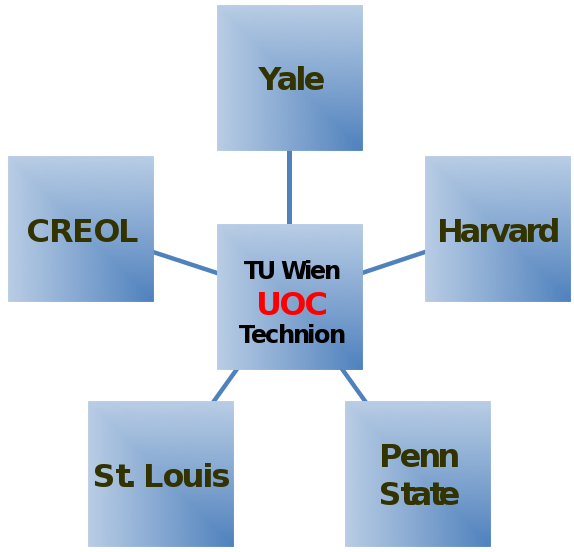Starting on March 1, 2016 (as an EC-supported MSCA-RISE-2015 - Marie Skłodowska-Curie Research and Innovation Staff Exchange (RISE) project; Project number: 691209), the Non-Hermitian Quantum Wave Engineering (NHQWAVE) project has actively pursued research activity and objectives in five research areas (which will be presented in more detail below and correspond to the project’s five distinct research work-packages, namely WP1-WP5), planned to be accomplished in a total period of 48 months (which is the time period comprising the lifetime of the NHQWAVE project). The project’s main scope is to investigate, develop and implement new resonant phenomena in novel complex non-hermitian system configurations, which can address the challenges of future optical devices.
The project’s research activity and objectives focus on the non-Hermitian photonics and parity-time (PT) symmetry in optics and condensed matter physics, and comprise the following five subprojects:
1. Symmetry breaking and exceptional points in complex lasers: understanding the role of coupling and symmetry breaking for a spatially non-uniform gain medium (pump engineering) in the lasing characteristics of novel coherent light sources; conducting systematic investigation of the combined role of exceptional points and resonator geometry in designing single mode and power-efficient nano-lasers. Work along this research line is encompassed in WP1.
2. Superconducting quantum metamaterials: establishing a strong link between the various phenomena observed in non-hermitian quantum and classical systems, with Superconducting- Quantum-Interference-Device-based (SQUID-based) quantum metamaterial lattices as a fundamental system to be investigated that can be both non-hermitian and nonlinear. Work along this research line is encompassed in WP2.
3. Asymmetric wave transport and topological phenomena in optical lattices: understanding of wave diffraction of PT (parity-time)-symmetric optical systems; beam engineering and group velocity dispersion-diffraction in non-hermitian environments such as optical lattices, photonic crystals and coupled cavities; developing theoretical techniques for the study of the effect of openness (gain or/and loss) in photonic systems that have topological properties (edge states, Zak phases). These methods will open the way for the experimental realization of topologically protected edge states in optical PT-symmetric lattices and for the direct measuring of topological Chern numbers. Work along this research line is encompassed in WP3.
4. Computational methods of condensed matter physics for non-hermitian photonic media: developing and applying theoretical, computational and experimental methods of condensed matter physics for the study of novel effects in non-Hermitian optical systems; bridging the gap between the phenomenological approach of gain and loss (usually employed in photonics) with the ab-initio simulations of lossy and active materials. Investigate broader aspects of various phase transitions associated with symmetry breaking of specific local order parameters, in various systems spanning from active nanoplasmonic devices to coupled semiconductor waveguide arrays. Work along this research line is encompassed in WP4.
5. Nonlinearity and non-hermiticity in disordered lattices and multimode fibers: developing theoretical techniques to study non-hermitian effects in non-linear optical devices, such as multimode fibers and optical lattices, that derive from the complexity in the open photonic structure used to confine light. Work along this research line is encompassed in WP5.
The NHQWAVE project comprises research collaboration between three European (MS/AC) beneficiaries, namely the University of Crete (Center for Quantum Complexity and Nanotechnology, Physics Department; which is the project’s coordinator), Technion-Israel Institute of Technology, and Technische Universitaet Wien (TU-Wien), as well as five partners USA (Harvard U., Yale U., Penn State U., Washington University in Saint Louis, U. of Central Florida (CREOL, The College of Optics and Photonics). The collaborative network is depicted in the schematic below. This collaboration of globally leading institutions with theoretical and experimental groups provides a highly incubating environment for innovative, high-caliber research.

A strong asset of the NHQWAVE project is the already existing expertise on non-hermitian photonics of its partners. In particular, CREOL, TU-Wien, Technion, UoC, Yale and Penn-State have actively participated in the creation, development and establishment of PT-symmetric optics and non-hermitian photonics as a new promising research area. There is a constructive interference and balance (among the eight project participants) between theoretical (mainly CREOL, UoC, TU-Wien, Harvard) and experimental (mainly Yale, St.Louis, Technion, Penn-State) participants.


